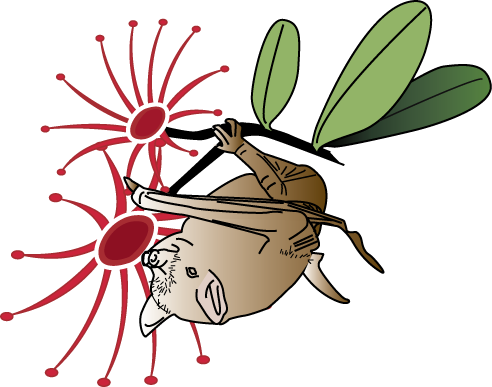The social organisation of Mystacina tuberculata: roost-selection and courtship behaviour
Background
The New Zealand lesser short-tailed bat, Mystacina tuberculata (Gray, 1843), is the only extant species in the family Mystacinidae (Dobson, 1875; Daniel, 1979), the only fully-temperate bat pollinator (Cummings et al., 2014), one of only two confirmed lek-breeding bats (Toth et al., 2015a), and the most terrestrial bat in the world (Riskin et al., 2006). Given the number of unique features exhibited by M. tuberculata, the species is of great interest to behavioural ecologists. There are three designated subspecies, of which two (M. t. aupourica and M. t. tuberculata) are classified by the New Zealand Department of Conservation as Nationally Endangered and the third (M. t. rhyacobia) as At Risk (O’Donnell et al., 2013). Under the IUCN Red List classification scheme, the species is listed as Vulnerable (O’Donnell, 2008).
Recent studies of a healthy M. t. rhyacobia population in Pureora Forest Park, Central North Island, have yielded new insights into the breeding behaviour of temperate bats (Toth et al., 2015a; Toth 2016a). In lekking species, males aggregate and display to attract females; they do not provide resources as an incentive to mating and take no active role in parental care of offspring (Bradbury, 1977; Höglund & Alatalo, 1995). As a result, there are fewer factors confounding female mate choice than in other mating systems. In M. tuberculata, males display to females during the summer and autumn (February – May) by singing and scent-marking (Toth et al., 2015a). Displays take place in singing roosts – usually small crevices in trees – which are spatially aggregated in the vicinity of communal roosts (Toth et al., 2015a). Although it was originally believed that singing roosts were defended by solitary males, recent research using automatic PIT-tag readers has revealed that some roosts (dubbed “timeshares”) are occupied sequentially by up to five different males throughout the night (Toth et al., 2015a). Whilst cooperation by related individuals has been found in other lekking species (Krakauer, 2005), Toth (2016a) determined that kin selection (Hamilton, 1964) is unlikely to be the sole explanation for this strategy. Other potential hypotheses include lower-quality males collaborating to hold a scarce resource and/or to produce a continuous display (singing is energetically costly, and weaker males may obtain better results by using more energy for shorter periods than by attempting to display all night). Individual males have been observed approaching their shared singing roost when females enter during others’ shifts, possibly indicating the use of a ‘sneaker’ strategy as an attempt to ‘steal’ matings (Toth et al., 2015a). The degree of social relatedness among timeshare males (e.g., time spent roosting or foraging together; length or frequency of association; engagement in age-related cohorts) is unknown (though see Toth 2016a; 2016b).
Research Aims and Objectives:
The purpose of my study is to examine the interactions and social-networking behaviour of Mystacina tuberculata together with the environmental factors that may influence roost selection.
Specific objectives are to:
- Identify environmental predictors of roost-selection and re-use by M. tuberculata in Pikiariki Ecological Area, Pureora Forest Park;
- Examine the use of time-share singing roosts in M. tuberculata with reference to the degree of social relatedness among time-share males;
- Examine the influence of male vocal parameters on mate selection by female M. tuberculata through playback experiments.
